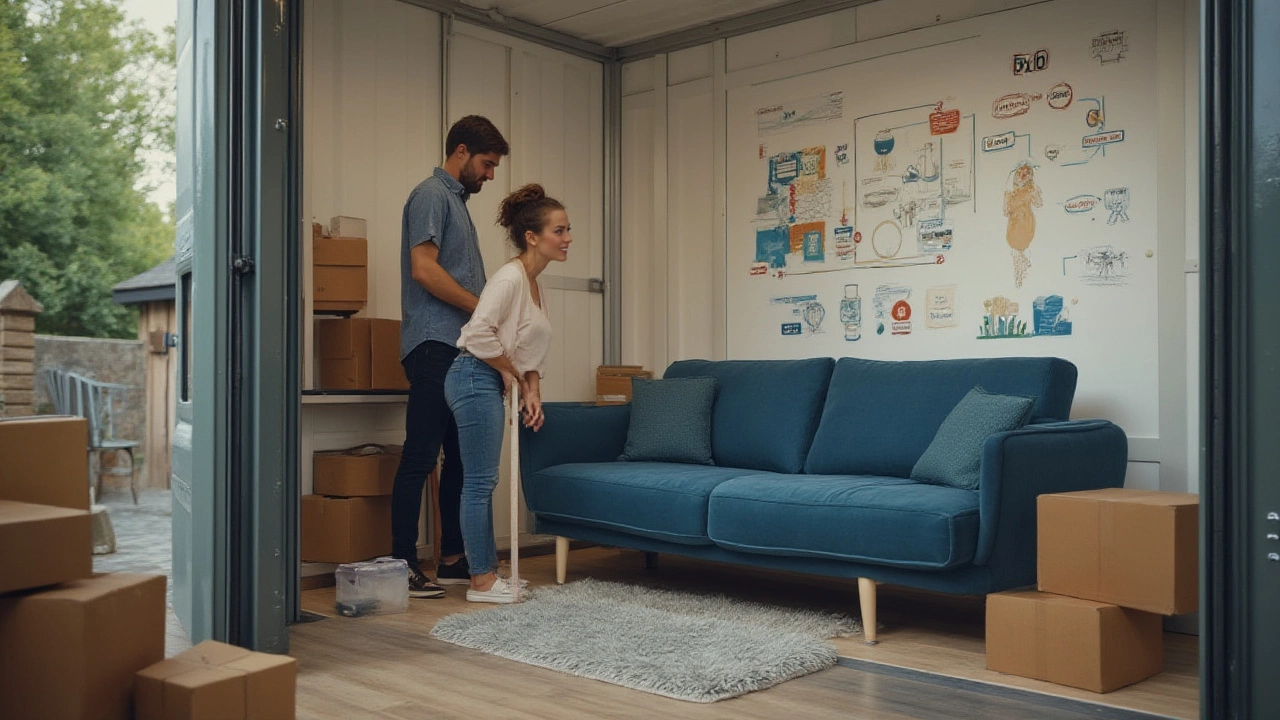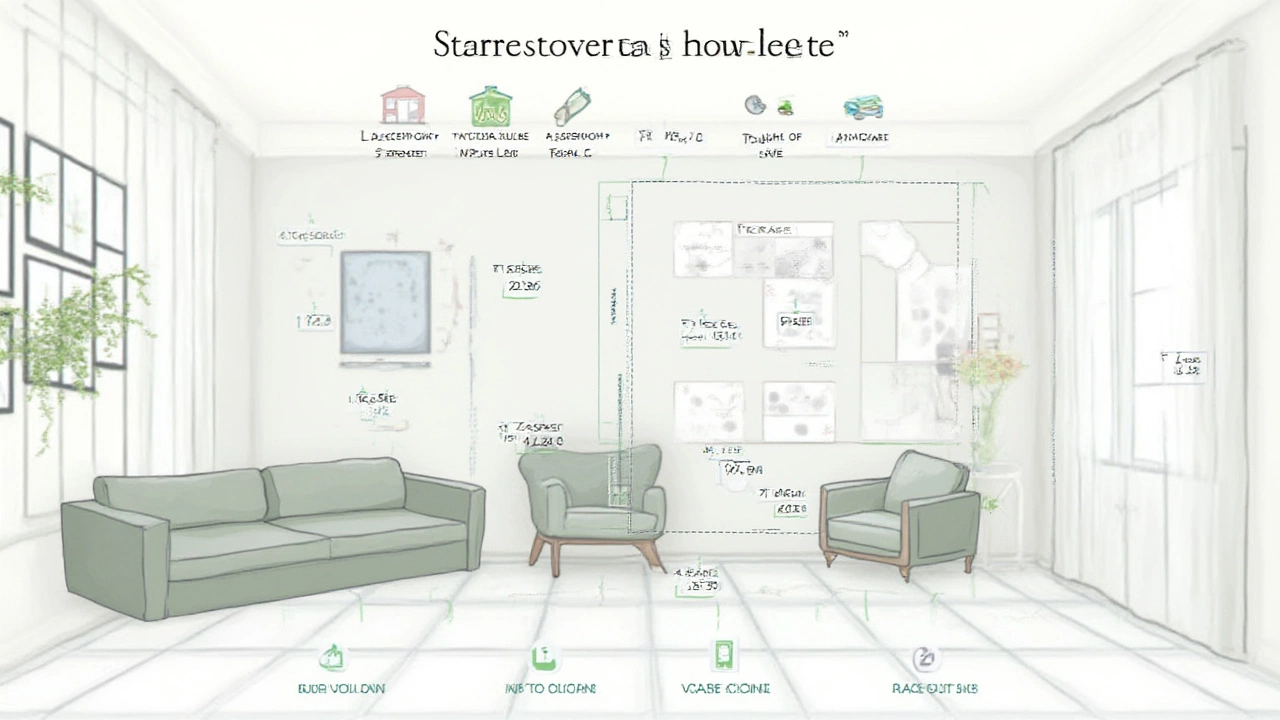Will a Couch Fit in a 5x10 Storage Unit? Size Guide & Expert Tips for Storage Success
 Jul, 14 2025
Jul, 14 2025
You’re staring at that 5x10 storage unit door, keys jingling in your hand, wondering if your couch will squeeze through. There’s a specific mix of hope and anxiety when you eyeball bulky furniture and a not-so-big storage space. Sure, the rental folks might rattle off dimensions and optimistically say, “Should be sweet” – but you’re not about to wing it with something as awkward as a full-size couch.
Understanding 5x10 Storage Unit Dimensions: Real Space Versus Perception
First thing: don’t trust your imagination on what 5 feet by 10 feet actually looks like. It’s not an elevator, but it’s also not as roomy as a bedroom. In actual metric, that’s about 1.5 metres by 3 metres, so right around 15 square feet. The standard ceiling height is typically eight feet (around 2.4 metres), but some older or exterior units can be lower.
Let’s lay out the numbers. A 5x10 storage unit gives you roughly 50 square feet of floor area. But since you can stack, you’re really working with about 400 cubic feet—if you use every inch up to that ceiling without blocking airflow.
Most residential couches range between 6 and 8 feet long (1.8–2.4m), 30–40 inches deep (roughly 76–101cm), and between 30–36 inches tall (76–91cm). L-shaped sectionals eat up even more floor space, while a small loveseat clocks in closer to 4.5 feet (about 1.4m) across. The question isn’t just will it physically fit, but do you have space to move, rearrange, and throw in a coffee table or two?
| Item | Size Range (Length x Depth x Height) |
|---|---|
| Standard 3-seater Sofa | 84" x 38" x 34" (213 x 97 x 86 cm) |
| Loveseat | 60" x 36" x 34" (152 x 91 x 86 cm) |
| 5x10 Storage Unit | 120" x 60" x 96" (305 x 152 x 244 cm) |
| L-shaped Sectional (2-piece) | 95" x 95" x 38" (241 x 241 x 97 cm) |
The big trick: a standard full-size sofa will fit – but you won’t get tons else in there, especially if you want to store it safely without wedging it against the wall and risking tears or bent frames.
What Types of Couches Actually Fit?
If you lug a massive sectional or chesterfield to a 5x10, expect a headache. Standard three-seater sofas? You’re in luck. According to the New Zealand Self Storage Association (yep, they’re real), almost 75% of customers storing in 5x10 units fit regular couches by angling them upright on the arm or side.
Loveseats, futons, and compact modular couches will slide in pretty easily. Even a pull-out sofa can squeeze, but measure carefully because the steel frame’s often heavier and bulkier. Some modern couches with detachable arms or legs make things smoother – if yours comes apart, disassemble what you can.
Here’s what generally won’t fit comfortably in a 5x10:
- Oversized sectionals, especially U-shaped or with chaise lounges
- Couches over 8 feet long
- Antique or vintage couches that don’t like being stacked or angled
- Anything with attached recliners (honestly, these are just trouble in small units)
But if you own a straightforward 2- or 3-seater, measure the piece, add 2–4 inches buffer around to avoid scuffing, and plan how you’ll swivel it through the unit’s doorway. Most storage unit doors are a bit under 4 feet wide (about 1.2 metres), which is broader than a standard house door but can surprise you if you have bulky arms or wide legs on your sofa.
Rough edges or ultra-tall backrests might need a tilt-and-twist. If you’re dealing with tight corners in the storage facility itself, take a tape measure and mark your entry path so you don’t hit a wall and have to double back. No shame — most folks misjudge how tricky soft furniture can be to manoeuvre.

How to Prepare Your Couch for Storage: Avoiding Damage and Drama
The battle isn’t just about what fits – it’s keeping your couch safe. Auckland gets humid, and storage units in damp climates like ours can mean your leather cracks or mildew gets comfy in the cushions. Here’s how to keep your stuff in top shape while making the most of a 5x10 unit:
- Clean everything first. Vacuum out crumbs (yes, even the ones from last winter’s Netflix binge), wipe down the upholstery, and let it fully dry. Spills can rot or grow mould over time.
- Break it down. If the legs unscrew, take them off. Any parts that disconnect safely, separate and bag up the hardware – label it so you don’t lose a crucial bolt.
- Wrap it right. Use moving blankets or old sheets, not plastic. Plastic traps moisture, so you’ll open your unit months later to a musty mess. Avoid tape on surfaces; it pulls colour and ruins fabric.
- Lash down cushions and bedding. Pack them upright or stack gently on top so they don’t warp out of shape. Avoid squashing everything against the unit’s wall.
- Store upright if possible. Placing a couch on its arm or back gives you more floor space for boxes and lowers the risk of crushing legs.
- Watch the airflow. Leave a little gap from the walls for air to move. Good ventilation stops that sour smell from building up.
- Plan your path. Position the couch near the back or against one wall. Boxes or lighter stuff stack on top but don’t overload – structural bends can happen to even the toughest sofa frame.
It sounds like overkill, but furniture repairers in Auckland say moisture and rough handling damage more sofas in storage than actual moving. Don’t give the mice or mildew an easy win.
Maximising the Space in Your 5x10 Storage Unit
If you’re only packing the couch, there’s no puzzle. But most people squeeze in a bunch of other gear – think bikes, side tables, or season’s worth of closet overspill. There’s a science to Tetris-ing these spaces so you can still grab box of winter clothes later without pulling everything out.
Try these ideas to stretch what that 50 square feet can do:
- Start with the biggest item first (the couch, obviously). Get it situated against a wall or upright in a stable position.
- Use the corners. Stack boxes of books, kitchen things, or shoes above sofa arms or on the seat surface itself. Even with a couch in there, you’ll have unused vertical space.
- Break down what you can. Take apart flat-pack furniture into pieces and slide them behind or alongside the couch.
- Use small shelves or a lightweight rack to create extra layers above the floor. Don't just make piles – unstable loads collapse and damage what’s underneath.
- Keep an inventory. Photograph the space when you fill it, so if you need the coffee table later, you’re not yanking the couch out just to check.
- Keep stuff off the ground with pallets or boards, especially if your unit isn’t climate-controlled. Water seepage isn’t common but happens, especially during Auckland’s rainy spell.
People who organise storage units for a living suggest always leaving a small “alley” down one side, even if it means packing a bit higher. It makes life a lot easier when you want to check on your stuff or add one more forgotten box last minute.

Common Mistakes and Quick Fixes When Storing a Couch
It’s easy to get caught out by rookie errors, and couches are big, awkward, and not built for storage room wrangling. Here’s what trips people up — so you can dodge it:
- Forgetting entry dimensions. The unit’s interior is roomy, but the roll-up door may be the limiter. Always downsize plans if your couch’s arms are especially chunky.
- Failing to clean or ventilate. Mould spreads fast, especially during those muggy Auckland summers. Anything with fabric needs to breathe.
- Stacking heavy stuff on cushions. This warps shapes and compresses down filling, making your flat-packing worse later.
- Propping directly on concrete. Wood and leather sitting straight on the floor soak up damp. Always put down a mat, tarp, or pallet.
- Packing without a path. Leave yourself a way in and out. There are horror stories of people who wedge the door shut with their sofa, then can't get at anything without an epic rearrange.
- Mixing sharp items nearby. Say goodbye to fabric if you dump loose tools or pointed furniture alongside the cushions.
Mistakes cost money, time, or both. If you’re unsure, double-check measurements and talk to the storage people. Most have seen every creative fail already and can save you a callout fee.
Modern Kiwi storage units are built weather-tight, but the inside environment is often at the mercy of whatever you drag in. Absorbent silica packs are cheap and keep humidity down, especially in changing seasons. And if you visit your stuff regularly, air it out or give cushions a fluff, so they’re not squashed by gravity over time.
If you think you need more space, some companies will let you add a mini locker or swap to a bigger unit for a weekend for less than what you might spend on a takeaway pizza in Auckland. And trust me, nothing’s as frustrating as cramming gear in like sardines and realising halfway through the move that the squeeze just isn’t worth it.
So, can a couch fit in a 5x10 storage unit? Absolutely, as long as you know what you’ve got, measure twice, and give yourself a fighting chance with prep and planning. Your sanity—and your couch—will thank you.